Passerine
Passerine
Jump to navigation
Jump to search
| Passerines Temporal range: Eocene-Recent, 52.5–0 Ma PreЄ Є O S D C P T J K Pg N | |
|---|---|
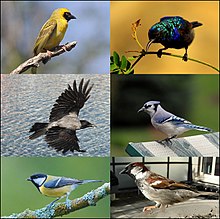 | |
| Clockwise from top right: Palestine sunbird (Cinnyris osea), blue jay (Cyanocitta cristata), house sparrow (Passer domesticus), great tit (Parus major), hooded crow (Corvus cornix), southern masked weaver (Ploceus velatus) | |
| Song of a purple-crowned fairywren (Malurus coronatus) | |
Scientific classification | |
| Kingdom: | Animalia |
| Phylum: | Chordata |
| Class: | Aves |
Clade: | Psittacopasserae |
| Order: | Passeriformes Linnaeus, 1758 |
Suborders | |
and see text | |
Diversity | |
Roughly 100 families, 6,409 species | |
A passerine is any bird of the order Passeriformes, which includes more than half of all bird species. Sometimes known as perching birds or – less accurately – as songbirds, passerines are distinguished from other orders of birds by the arrangement of their toes (three pointing forward and one back), which facilitates perching. With more than 110 families and some 6,409 identified species,[1][2] Passeriformes is the largest order of birds and among the most diverse orders of terrestrial vertebrates.[3]
The passerines contain several groups of brood parasites such as the viduas, cuckoo-finches, and the cowbirds. Most passerines are omnivorous, while the shrikes are carnivorous.
The terms "passerine" and "Passeriformes" are derived from the scientific name of the house sparrow, Passer domesticus, and ultimately from the Latin term passer, which refers to sparrows and similar small birds.
Contents
1 Description
2 Anatomy
3 Eggs and nests
4 Origin and evolution
4.1 Fossil record
4.1.1 Earliest passerines
4.1.2 Early European passerines
4.1.3 American fossils
5 Systematics and taxonomy
6 Taxonomic list of Passeriformes families
6.1 Arrangement of families
6.2 Suborder Acanthisitti
6.3 Suborder Tyranni (Suboscines)
6.4 Suborder Passeri (songbirds or oscines)
6.5 Phylogeny
7 Footnotes
8 References
9 External links
Description[edit]
This section does not cite any sources. (April 2018) (Learn how and when to remove this template message) |
The order is divided into three suborders, Tyranni (suboscines), Passeri (oscines), and the basal Acanthisitti[4]. Oscines have the best control of their syrinx muscles among birds, producing a wide range of songs and other vocalizations (though some of them, such as the crows, do not sound musical to human beings); some such as the lyrebird are accomplished imitators. The acanthisittids or New Zealand wrens are tiny birds restricted to New Zealand, at least in modern times; they were long placed in Passeri; their taxonomic position is uncertain, although they seem to be a distinct and very ancient group.

Pterylosis or the feather tracts in a typical passerine
Most passerines are smaller than typical members of other avian orders. The heaviest and altogether largest passerines are the thick-billed raven and the larger races of common raven, each exceeding 1.5 kg (3.3 lb) and 70 cm (28 in). The superb lyrebird and some birds-of-paradise, due to very long tails or tail coverts, are longer overall. The smallest passerine is the short-tailed pygmy tyrant, at 6.5 cm (2.6 in) and 4.2 g (0.15 oz).
Anatomy[edit]
The foot of a passerine has three toes directed forward and one toe directed backward, called anisodactyl arrangement. This arrangement enables the passerine birds to perch upon vertical surfaces, such as trees and cliffs. The toes have no webbing or joining, but in some cotingas, the second and third toes are united at their basal third. The hind toe joins the leg at the same level as the front toes. The passeriformes have this toe arrangement in common with hunting birds like eagles and falcons.
The leg arrangement of passerine birds contains a special adaptation for perching. A tendon in the rear of the leg running from the underside of the toes to the muscle behind the tibiotarsus will automatically be pulled and tighten when the leg bends, causing the foot to curl and become stiff when the bird lands on a branch. This enables passerines to sleep while perching without falling off.[5][6]
Most passerine birds develop 12 tail feathers, although the superb lyrebird has 16.[7] Certain species of passerines have stiff tail feathers, which help the birds balance themselves when perching upon vertical surfaces. Some passerines, specifically in the family Ploceidae, are well known for their elaborate sexual ornaments, including extremely long tails. A well-known example is the long-tailed widowbird.
Eggs and nests[edit]
The chicks of passerines are altricial: blind, featherless, and helpless when hatched from their eggs. Hence, the chicks require extensive parental care. Most passerines lay coloured eggs, in contrast with nonpasserines, most of whose eggs are white except in some ground-nesting groups such as Charadriiformes and nightjars, where camouflage is necessary, and in some parasitic cuckoos, which match the passerine host's egg. Vinous-throated parrotbill has two egg colours, white and blue. This can prevent the brood parasitic Common cuckoo.
Clutches vary considerably in size: some larger passerines of Australia such as lyrebirds and scrub-robins lay only a single egg, most smaller passerines in warmer climates lay between two and five, while in the higher latitudes of the Northern Hemisphere, hole-nesting species like tits can lay up to a dozen and other species around five or six.
The family Viduidae do not build their own nests, instead, they lay eggs in other birds' nests.
Origin and evolution[edit]
The evolutionary history of the passerine families and the relationships among them remained rather mysterious until the late 20th century. In many cases, passerine families were grouped together on the basis of morphological similarities that, it is now believed, are the result of convergent evolution, not a close genetic relationship. For example, the wrens of the Americas and Eurasia; those of Australia; and those of New Zealand look superficially similar and behave in similar ways, and yet belong to three far-flung branches of the passerine family tree; they are as unrelated as it is possible to be while remaining Passeriformes.[8]
Much research remains to be done, but advances in molecular biology and improved paleobiogeographical data gradually are revealing a clearer picture of passerine origins and evolution that reconciles molecular affinities, the constraints of morphology and the specifics of the fossil record.[9][10] The first passerines are now thought to have evolved in the Southern Hemisphere in the late Paleocene or early Eocene, around 50 million years ago.[11][10]
The initial split was between the New Zealand wrens (Acanthisittidae) and all other passerines, and the second split involved the Tyranni (suboscines) and the Passeri (oscines or songbirds). The latter experienced a great radiation of forms out of the Australian continent. A major branch of the Passeri, parvorder Passerida, expanded deep into Eurasia and Africa, where a further explosive radiation of new lineages occurred.[10] This eventually led to three major Passerida lineages comprising about 4,000 species, which in addition to the Corvida and numerous minor lineages make up songbird diversity today. Extensive biogeographical mixing happens, with northern forms returning to the south, southern forms moving north, and so on.
Fossil record[edit]
Earliest passerines[edit]

Male superb lyrebird (Menura novaehollandiae): This very primitive songbird shows strong sexual dimorphism, with a peculiarly apomorphic display of plumage in males.
Perching bird osteology, especially of the limb bones, is rather diagnostic.[12] However, the early fossil record is poor because the first Passeriformes were apparently on the small side of the present size range, and their delicate bones did not preserve well. Queensland Museum specimens F20688 (carpometacarpus) and F24685 (tibiotarsus) from Murgon, Queensland, are fossil bone fragments initially assigned to Passeriformes.[13] However, the material is too fragmentary and their affinities have been questioned.[14] Several more recent fossils from the Oligocene of Europe that are more complete definitely represent early passeriforms, although their exact position in the evolutionary tree is not known.
From the Bathans Formation at the Manuherikia River in Otago, New Zealand, MNZ S42815 (a distal right tarsometatarsus of a tui-sized bird) and several bones of at least one species of saddleback-sized bird have recently been described. These date from the Early to Middle Miocene (Awamoan to Lillburnian, 19–16 mya).[15]
Modern knowledge about the living passerines' interrelationships (see the list of families below) suggests that the last common ancestor of all living Passeriformes was a small forest bird, probably with a stubby tail[16] and an overall drab coloration, but possibly with marked sexual dimorphism. The latter trait seems to have been lost and re-evolved multiple times in songbird evolution alone, judging from its distribution among the extant lineages.
Sexual dichromatism is very rare among the basal lineages of Passerida, and probably their plesiomorphic condition. But among the youngest passerid clade, the Passeroidea, extremely colorful males and drab females are common, if not the rule. On the other hand, among the basalmost Passeri a considerable number of strongly dimorphic lineages exist, too, such as the very ancient Menuridae, as well as many Meliphagoidea and Corvoidea. Sexual dimorphism is also not uncommon in the Acanthisittidae and prominent in some suboscines such as the Pipridae and Cotingidae.
Early European passerines[edit]
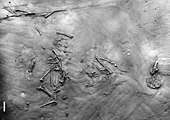
Wieslochia fossil
In Europe, perching birds are not too uncommon in the fossil record from the Oligocene onward, but most are too fragmentary for a more definite placement:
Wieslochia (Early Oligocene of Frauenweiler, Germany)
Jamna (Early Oligocene of Jamna Dolna, Poland)
Resoviaornis (Early Oligocene of Wola Rafałowska, Poland)- Passeriformes gen. et sp. indet. (Early Oligocene of Luberon, France) – suboscine or basal[17]
- Passeriformes gen. et spp. indet. (Late Oligocene of France) – several suboscine and oscine taxa[18]
- Passeriformes gen. et spp. indet. (Middle Miocene of France and Germany) – basal?[19]
- Passeriformes gen. et spp. indet. (Sajóvölgyi Middle Miocene of Mátraszőlős, Hungary) – at least 2 taxa, possibly 3; at least one probably Oscines[20]
- Passeriformes gen. et sp. indet. (Middle Miocene of Felsőtárkány, Hungary) – oscine?[21]
- Passeriformes gen. et sp. indet. (Late Miocene of Polgárdi, Hungary) – Sylvioidea (Sylviidae? Cettiidae?)[22]
Wieslochia was possibly not a member of any extant suborder. That not only the Passeri expanded much beyond their region of origin is proven by an undetermined broadbill (Eurylaimidae) from the Early Miocene (roughly 20 mya) of Wintershof, Germany, and the indeterminant Late Oligocene suboscine from France listed above. Even very basal Passeriformes might have been common in Europe until the Middle Miocene, some 12 mya.[23] Extant Passeri super-families were quite distinct by that time and are known since about 12–13 mya when modern genera were present in the corvoidean and basal songbirds. The modern diversity of Passerida genera is known mostly from the Late Miocene onwards and into the Pliocene (about 10–2 mya). Pleistocene and early Holocene lagerstätten (<1.8 mya) yield numerous extant species, and many yield almost nothing but extant species or their chronospecies and paleosubspecies.
American fossils[edit]
In the Americas, the fossil record is more scant before the Pleistocene, from which several still-existing suboscine families are documented. Apart from the indeterminable MACN-SC-1411 (Pinturas Early/Middle Miocene of Santa Cruz Province, Argentina),[24] an extinct lineage of perching birds has been described from the Late Miocene of California, United States: the Palaeoscinidae with the single genus Paleoscinis. "Palaeostruthus" eurius (Pliocene of Florida) probably belongs to an extant family, most likely passeroidean.
Systematics and taxonomy[edit]
Corvida and Passerida were classified as parvorders in the suborder Passeri; in accord with the usual taxonomic practice, they would probably be ranked as infraorders. As originally envisioned in the Sibley-Ahlquist taxonomy, they contained, respectively, the large superfamilies Corvoidea and Meliphagoidea, as well as minor lineages, and the superfamilies Sylvioidea, Muscicapoidea, and Passeroidea.
The arrangement has been found to be oversimplified by more recent research. Since the mid-2000s, literally, dozens of studies are being published that try rather successfully to resolve the phylogeny of the passeriform radiation. For example, the Corvida in the traditional sense was a rather arbitrary assemblage of early and/or minor lineages of passeriform birds of Old World origin, generally from the region of Australia, New Zealand, and Wallacea. The Passeri, though, can be made monophyletic by moving some families about, but the "clean" three-superfamily-arrangement has turned out to be far more complex and it is uncertain whether future authors will stick to it.
Major "wastebin" families such as the Old World warblers and Old World babblers have turned out to be paraphyletic and are being rearranged. Several taxa turned out to represent highly distinct species-poor lineages, so new families had to be established, some of them – like the stitchbird of New Zealand and the Eurasian bearded reedling – monotypic with only one living species.[25] In the Passeri alone, a number of minor lineages will eventually be recognized as distinct superfamilies. For example, the kinglets constitute a single genus with less than 10 species today but seem to have been among the first perching bird lineages to diverge as the group spread across Eurasia. No particularly close relatives of them have been found among comprehensive studies of the living Passeri, though they might be fairly close to some little-studied tropical Asian groups. Treatment of the nuthatches, wrens, and their closest relatives as a distinct super-family Certhioidea is increasingly considered justified; the same might eventually apply to the tits and their closest relatives.
This process is still continuing. Therefore, the arrangement as presented here is subject to change. However, it should take precedence over unreferenced conflicting treatments in family, genus, and species articles here.
Taxonomic list of Passeriformes families[edit]

New Zealand rock wren (Xenicus gilviventris), one of the two surviving species of suborder Acanthisitti
This list is in taxonomic order, placing related species/groups next to each other. The Passerida subdivisions are updated as needed from the default sequence of the Handbook of the Birds of the World,[26] based on the most modern and comprehensive studies.[27]
Arrangement of families[edit]
The families are sorted into a somewhat novel sequence unlike that in older works, where e.g. Corvidae are placed last. This is because so many reallocations have taken place since about 2005 that a definite taxonomy has not been established yet, although the phylogeny is by and large resolved. The present sequence is an attempt to preserve as much of the traditional sequence while giving priority to adequately addressing the phylogenetic relationships between the families. Based on John Boyd's Taxonomy in Flux Checklist 3.5.[28]
Suborder Acanthisitti[edit]
Acanthisittidae: New Zealand wrens

Javan banded pitta (Hydrornis guajanus), an Old World suboscine.
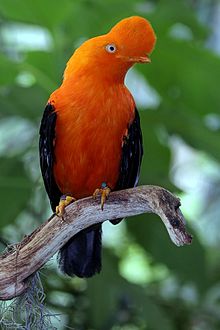
Andean cock-of-the-rock (Rupicola peruvianus) a New World suboscine
Suborder Tyranni (Suboscines)[edit]
Infraorder Eurylaimides – Old World suboscines (or broad-billed suboscines), probably a separate suborder- Superfamily Pittoidea
Pittidae: pittas
- Superfamily Eurylaimoidea – broadbills and allies
Eurylaimidae: broadbills
Philepittidae: asities
Sapayoidae: broad-billed sapayoa
- Superfamily Pittoidea
Infraorder Tyrannides – New World suboscines- Superfamily Tyrannoidea – "bronchophones"
Pipridae: manakins
Cotingidae: cotingas
Tityridae: tityras and allies
Tyrannidae: tyrant flycatchers
- Superfamily Furnarioidea – tracheophones
Melanopareiidae: crescentchests
Thamnophilidae: antbirds
Conopophagidae: gnateaters and gnatpittas
Grallariidae: antpittas
Rhinocryptidae: typical tapaculos
Formicariidae: antthrushes
Furnariidae: ovenbirds and woodcreepers
- Superfamily Tyrannoidea – "bronchophones"
Suborder Passeri (songbirds or oscines)[edit]
Infraorder Menurides – the most ancient true songbirds, endemic to Australia, sometimes considered a superfamily "Menuroidea"[verification needed]
Menuridae: lyrebirds
Atrichornithidae: scrub-birds

Male regent bowerbird (Sericulus chrysocephalus, Ptilonorhynchidae)
Infraorder Climacterides – Possible superfamily "Ptilonorhynchoidea"[verification needed] – bowerbirds and Australian treecreepers, endemic to Australia, New Guinea, two very dissimilar families, one smallish and inconspicuous, the other sizeable, usually brightly colored and/or conspicuously vocal, and with extremely unusual mating habits
Climacteridae: Australian treecreepers
Ptilonorhynchidae: bowerbirds
Infraorder Meliphagides – mainly insectivores and nectarivores, distribution centered on Australo-Melanesian region extending into surroundings, notably the Pacific.
Meliphagoidea
Maluridae: fairywrens, emu-wrens and grasswrens
Dasyornithidae: bristlebirds, formerly in Acanthizidae
Meliphagidae: honeyeaters
Pardalotidae: pardalotes
Acanthizidae: scrubwrens, thornbills, and gerygones
Infraorder Orthonychides – logrunners and pseudo-babblers, insectivores, endemic to Australia, New Guinea, mid-sized and rather inconspicuous, wings short and round but tails well-developed plumage grey and brown with black and white markings, males and females look alike
Orthonychidae: logrunners
Pomatostomidae: pseudo-babblers
Infraorder Corvides – a highly diverse group of global distribution, but most plentiful in the Australasian region and surroundings: The oldest truly globally successful group of passerines, they include among them what may well be the most intelligent and the most spectacular of the order.
Mohouoidea- Mohouidae
Pachycephaloidea
Pachycephalidae: whistlers
Oreoicidae: Australo-Papuan bellbirds
Psophodidae: quail-thrushes & jewel-babblers
- Orioloidea
Eulacestomidae: Wattled ploughbills
Neosittidae: sittellas
Oriolidae: Old World orioles & figbirds
Paramythiidae: painted berrypeckers
Psophodidae: whipbirds & wedgebills
Vireonidae: vireos
Campephagoidea
Campephagidae: cuckooshrikes and trillers
Malaconotoidea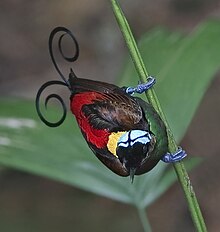
Wilson's bird-of-paradise (Cicinnurus respublica) a corvoid oscine.
Artamidae: woodswallows, butcherbirds, currawongs, and Australian magpie
Machaerirhynchidae: boatbills
Aegithinidae: ioras
Pityriaseidae: Bornean bristlehead, tentatively placed here
Malaconotidae: puffback shrikes, bush shrikes, tchagras, and boubous
Platysteiridae: wattle-eyes and relatives, formerly in Passerida, probably paraphyletic
Vangidae: vangas
Corvoidea
Rhipiduridae: fantails
Dicruridae: drongos
Ifritidae: blue-capped ifrit
Melampittidae: melampittas
Corcoracidae: white-winged chough and apostlebird
Paradisaeidae: birds-of-paradise
Monarchidae: monarch flycatchers
Laniidae: shrikes
Corvidae: crows, ravens, and jays
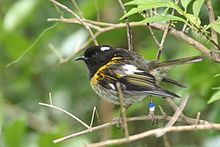
Male stitchbird or hihi (Notiomystis cincta) showing convergence with honeyeaters
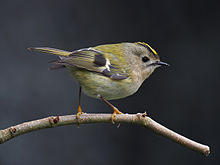
Tiny goldcrest (Regulus regulus) belongs to a minor but highly distinct lineage of Passeri

Reed warblers, such as this Blyth's reed warbler (Acrocephalus dumetorum), are now in the Acrocephalidae
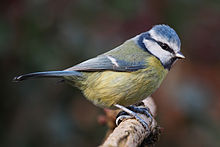
blue tit (Cyanistes caeruleus) and its relatives stand well apart from rest of the Sylvioidea sensu lato

Brown-headed nuthatch (Sitta pusilla), nuthatches can climb downwards head-first

Hermit thrush (Catharus guttatus), like many Muscicapoidea a stout and cryptic bird with complex vocalizations.

Like these male (right) and female Gouldian finches (Erythrura gouldiae), many Passeroidea are very colorful
Infraorder Passerides- Melanocharitida
Melanocharitidae (berrypeckers and longbills)
- Cnemophilida
Cnemophilidae (satinbirds)
- Petroicida
Callaeidae (New Zealand wattlebirds)
Notiomystidae (stitchbird)
Petroicidae (Australian robins)
- Eupetida – rockfowl and allies, eat large arthropods and sometimes small vertebrates. Relictual distribution in three areas of the Old World tropics, mid-sized to large songbirds with strong legs, adapted to move long distances on foot across rough ground, males and females look alike
Picathartidae (rockfowl)
Chaetopidae (rock-jumpers), recently split from the Turdidae
Eupetidae (Malaysian rail-babbler), recently split from the Cinclosomatidae
Paroidea – titmice and allies, might be included in Sylvioidea, feed mainly on arthropods, seeds, and berries, widely distributed but absent from South America and the Australian region[verification needed], smallish round-bodied acrobatic birds, often brightly colored with large patches of yellow, blue, green, black and white, males and females usually look quite alike
Stenostiridae: ("flycatcher-tits"), a newly assembled family.
Hyliotidae: (hyliotas), recently split from the Sylviidae, basal to/in Passerida, restricted to the Afrotropics, resemble "Old World warblers", but quite colorful
Remizidae: (penduline tits), sometimes included in the Paridae
Paridae: (tits, chickadees, and titmice)
Sylvioidea: – "Old World warblers/babblers" and allies, generally insectivores, sometimes supplemented with berries, distribution centered on the Indo-Pacific region, few occur in the Australian region and fewer still in the Americas, usually slender and drab birds, few have pronounced sexual dimorphism
Nicatoridae: (nicators), have been classed as bulbuls in the past, but appear to have no close relatives
Panuridae: (bearded reedling), formerly classed as a parrotbill, but seems to be closest to the larks
Alaudidae: (larks)
Macrosphenidae: African warblers such as longbills and crombecs, a recently proposed family whose composition is still uncertain
Cisticolidae: cisticolas and allies
Acrocephalidae: marsh- and tree-warblers, recently split from the Sylviidae
Pnoepygidae: pygmy wren-babblers, apparently unrelated to other babblers
Locustellidae: grass-warblers and allies, recently split from the Sylviidae
Donacobiidae: the black-capped donacobius, previously classed as a wren, but probably closest to the Locustellidae or Bernieridae
Bernieridae: Malagasy warblers, a newly assembled family
Hirundinidae: swallows and martins
Pycnonotidae: bulbuls
Phylloscopidae: leaf-warblers and allies, recently split from the Sylviidae
Cettiidae: ground-warblers and allies, recently split from the Sylviidae- Hyliidae
Aegithalidae: long-tailed tits or bushtits[29]
Sylviidae: Sylvia warblers and allies
Zosteropidae: white-eyes and allies
Timaliidae: tree babblers
Pellorneidae: ground babblers
Leiothrichidae: laughingthrushes and allies
Reguloidea
Regulidae (kinglets), tiny forest-dwelling insectivores, found only in the Northern Hemisphere, greenish above, whitish below and striking (at close range) head pattern of black and yellow to red stripes, sexual dimorphism slight
Bombycilloidea – waxwings and allies, included in the Muscicapoidea if Sittoidea/Certhioidea are also included there, omnivores but strongly prefer juicy fruit and nectar, Laurasian, essentially[verification needed] limited to the Northern Hemisphere, mid-sized and typically fairly inconspicuous except for their habit of roaming around in noisy flocks, plumage typically grey-hued and with silk-like texture, but many have a conspicuous black face and/or yellow ornaments, several melanic lineages, sexual dimorphism slight if any. Hylocitrea might be included here as monotypic family.
Elachuridae: spotted elachura
Mohoidae[30][31]
Lesser striped swallow (Cecropis abyssinica), showing some apomorphies of its ancient yet highly advanced lineage.
Ptiliogonatidae: silky flycatchers, tentatively placed here
Bombycillidae: waxwings
Dulidae: palmchat, tentatively placed here
Hypocoliidae: hypocolius, tentatively placed here
Certhioidea – wrens, treecreepers and allies. Sometimes included in Muscicapoidea. Occur in the Americas and Eurasia, though mostly north of the Alpide belt. Distribution and the basal fossil Certhiops indicates the Certhioidea probably originated around the end of the Paleogene somewhere around the North Atlantic. Small, often tiny, tend to be conspicuously plump but nimble; many accomplished climbers. Plumage extremely cryptic or somewhat colorful, in the latter case typically blue-grey at least on the upperside. Sexes look identical or almost so, but may differ strongly in vocalizations.
Tichodromadidae: wallcreeper: Traditionally placed as a subfamily of the nuthatches and more rarely of the treecreepers, no study has been able to verify either placement this far. Thus it is better considered a monotypic family, at least for the time being.
Sittidae: nuthatches
Certhiidae: treecreepers
Salpornithidae: spotted creepers. Tentatively placed here; often considered a subfamily of the Certhidae.
Troglodytidae: wrens
Polioptilidae: gnatcatchers
Muscicapoidea – "Old World flycatchers", starlings and allies. Mostly insectivores, near-global distribution centered on Old World tropics. One family endemic to Americas. Nearly absent (except introductions) from the Australian region. Usually rather robust for their size, some species (especially of Cinclidae, Buphagidae and Mimidae) are quite dark and dull while others are commonly colorful or/and iridescent. Sexual dimorphism often absent, sometimes pronounced.
Cinclidae: dippers, the most aquatic members of the whole clade.
Turdidae: thrushes and allies. Monophyly needs confirmation.
Muscicapidae: Old World flycatchers and chats. Monophyly needs confirmation.
Buphagidae: oxpeckers. Formerly usually included in Sturnidae.
Sturnidae: starlings and possibly Philippine creepers. Placement of latter in Muscicapoidea seems good, but inclusion in Sturnidae requires confirmation; possibly distinct family Rhabdornithidae.
Mimidae: mockingbirds and thrashers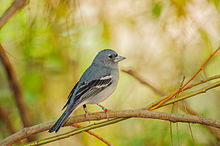
Gran Canaria blue chaffinch (male).
Passeroidea – "finches", "New World warblers/blackbirds" and allies. Mostly herbivores including many seed-eaters but some specialized insectivores; near-global distribution centered on Palearctic and Americas. Includes the nine-primaried oscines (probably a subclade). A very high proportion of colorful and highly sexually dimorphic forms.
Promeropidae (Sugarbirds), living fossils with a nondescript "honeyeater" or "warbler" phenotype, a Capensis relict lineage only found in Africa south of the Equatorial region, Include keystone species for fynbos and some Afromontane forest ecosystems, sexual dimorphism does not appear pronounced, but includes many little-studied species
Arcanatoridae (Dapplethroat & allies)
Dicaeidae (flowerpeckers), sunbirds and flowerpeckers, might be included in Passeroidea, eat mostly nectar, pollen, and berries, supplemented with arthropods, generally restricted to the Old World tropics, plumage usually extremely colorful at least in males, usually a few contrasting hues (commonly including black and/or white, and usually including red) and in some with metallic sheen, sexual dimorphism usually pronounced, females in most species greenish above, lighter below
Nectariniidae: sunbirds
Chloropseidae: leafbirds
Irenidae: fairy-bluebirds.
Urocynchramidae: Przewalski's finch. Recently split from Fringillidae; tentatively placed here.
Peucedramidae: olive warbler
Prunellidae: accentors
Ploceidae: weavers. Certain members of Ploceidae, such as the long-tailed widowbird are well known for their elaborate sexual ornaments.
Viduidae: indigobirds and whydahs
Estrildidae: estrildid finches (waxbills, munias and allies)
Passeridae true sparrows
Motacillidae: wagtails and pipits
Nine-primaried oscines:
Fringillidae: true finches and Hawaiian honeycreepers. Possibly polyphyletic.
Calcariidae: longspurs and snow buntings
Emberizidae: buntings
Passerellidae: American sparrows
Icteridae: grackles, New World blackbirds, and New World orioles
Parulidae: New World warblers
Thraupidae: tanagers and allies
Cardinalidae: cardinals
Passerida incertae sedis
Scotocercidae: streaked scrub warbler
Rhagologidae: mottled whistler
Prionopidae: helmetshrikes and woodshrikes
- Melanocharitida
Phylogeny[edit]
Living Passeriformes based on the "Taxonomy in Flux family phylogenetic tree" by John Boyd.[28]
| Passeriformes classification | |||||||||||||||||||||||||||||||||||||||||||||||||||||||||||||||||||||||||||||||||||||||||||||||||||||||||||||||||||||||||||||||||||||||||||||||||||||||||||||||||||||||||||||||||||||||||||||||||||||||||||||||||||||||||||||||||||||||||||||||||||||||||||||||||||||||||||||||||||||||||||||||||||||||||||||||||||||||||||||||||||||||||||||||||||||||||||||||||||||||||||||||||||||||||||||||||||||||||||||||||||||||||||||||||||||||||||||||||||||||||||||||||||||||||||||||||||||||||||||||||||||||||||||||||||||||||||||||||||||||||||||||||||||||||||||||||||||||||||||||||||||||||||||||||||||||||||||||||||||||||||||||||||||||||||||||||||||||||||||||||||||||||||||||||||||||||||||||||||||||||||||||||||||||||||||||||||||||||||||||||||||||||||||||||||||||||||||||||||||||||||||||||||||||||||||||||||||||||||||||||||||||||||||||||||||||||||||||
|---|---|---|---|---|---|---|---|---|---|---|---|---|---|---|---|---|---|---|---|---|---|---|---|---|---|---|---|---|---|---|---|---|---|---|---|---|---|---|---|---|---|---|---|---|---|---|---|---|---|---|---|---|---|---|---|---|---|---|---|---|---|---|---|---|---|---|---|---|---|---|---|---|---|---|---|---|---|---|---|---|---|---|---|---|---|---|---|---|---|---|---|---|---|---|---|---|---|---|---|---|---|---|---|---|---|---|---|---|---|---|---|---|---|---|---|---|---|---|---|---|---|---|---|---|---|---|---|---|---|---|---|---|---|---|---|---|---|---|---|---|---|---|---|---|---|---|---|---|---|---|---|---|---|---|---|---|---|---|---|---|---|---|---|---|---|---|---|---|---|---|---|---|---|---|---|---|---|---|---|---|---|---|---|---|---|---|---|---|---|---|---|---|---|---|---|---|---|---|---|---|---|---|---|---|---|---|---|---|---|---|---|---|---|---|---|---|---|---|---|---|---|---|---|---|---|---|---|---|---|---|---|---|---|---|---|---|---|---|---|---|---|---|---|---|---|---|---|---|---|---|---|---|---|---|---|---|---|---|---|---|---|---|---|---|---|---|---|---|---|---|---|---|---|---|---|---|---|---|---|---|---|---|---|---|---|---|---|---|---|---|---|---|---|---|---|---|---|---|---|---|---|---|---|---|---|---|---|---|---|---|---|---|---|---|---|---|---|---|---|---|---|---|---|---|---|---|---|---|---|---|---|---|---|---|---|---|---|---|---|---|---|---|---|---|---|---|---|---|---|---|---|---|---|---|---|---|---|---|---|---|---|---|---|---|---|---|---|---|---|---|---|---|---|---|---|---|---|---|---|---|---|---|---|---|---|---|---|---|---|---|---|---|---|---|---|---|---|---|---|---|---|---|---|---|---|---|---|---|---|---|---|---|---|---|---|---|---|---|---|---|---|---|---|---|---|---|---|---|---|---|---|---|---|---|---|---|---|---|---|---|---|---|---|---|---|---|---|---|---|---|---|---|---|---|---|---|---|---|---|---|---|---|---|---|---|---|---|---|---|---|---|---|---|---|---|---|---|---|---|---|---|---|---|---|---|---|---|---|---|---|---|---|---|---|---|---|---|---|---|---|---|---|---|---|---|---|---|---|---|---|---|---|---|---|---|---|---|---|---|---|---|---|---|---|---|---|---|---|---|---|---|---|---|---|---|---|---|---|---|---|---|---|---|---|---|---|---|---|---|---|---|---|---|---|---|---|---|---|---|---|---|---|---|---|---|---|---|---|---|---|---|---|---|---|---|---|---|---|---|---|---|---|---|---|---|---|---|---|---|---|---|---|---|---|---|---|---|---|---|---|---|---|---|---|---|---|---|---|---|---|---|---|---|---|---|---|---|---|---|---|---|---|---|---|---|---|---|---|---|---|---|---|---|---|---|---|---|---|---|---|---|---|---|---|---|---|---|---|---|---|---|---|---|---|---|---|---|---|---|---|---|---|---|---|---|---|---|---|---|---|---|---|---|---|---|---|---|---|---|---|---|---|---|---|---|---|---|---|---|---|---|---|---|---|---|---|---|---|---|---|---|---|---|---|---|---|---|---|---|---|---|---|---|---|---|---|---|---|---|---|---|---|---|---|---|---|---|---|---|---|---|---|---|---|---|---|---|---|---|---|---|---|---|---|---|---|---|---|---|---|---|---|---|---|---|---|---|---|---|---|---|---|---|---|---|---|---|---|---|---|---|---|---|---|---|---|---|---|---|---|---|---|---|---|---|---|---|---|---|---|---|---|---|---|---|---|---|---|---|---|---|---|---|---|---|---|---|---|---|---|---|---|---|---|---|---|---|---|---|---|---|---|---|---|---|---|---|---|---|---|---|
.mw-parser-output table.cladeborder-spacing:0;margin:0;font-size:100%;line-height:100%;border-collapse:separate;width:auto.mw-parser-output table.clade table.cladewidth:100%.mw-parser-output table.clade tdborder:0;padding:0;vertical-align:middle;text-align:center.mw-parser-output table.clade td.clade-labelwidth:0.8em;border:0;padding:0 0.2em;vertical-align:bottom;text-align:center.mw-parser-output table.clade td.clade-slabelborder:0;padding:0 0.2em;vertical-align:top;text-align:center.mw-parser-output table.clade td.clade-barvertical-align:middle;text-align:left;padding:0 0.5em.mw-parser-output table.clade td.clade-leafborder:0;padding:0;text-align:left;vertical-align:middle.mw-parser-output table.clade td.clade-leafRborder:0;padding:0;text-align:right
|
Footnotes[edit]
^ Mayr, Ernst (1946). "The Number of Species of Birds" (PDF). The Auk. 63 (1): 67. doi:10.2307/4079907..mw-parser-output cite.citationfont-style:inherit.mw-parser-output qquotes:"""""""'""'".mw-parser-output code.cs1-codecolor:inherit;background:inherit;border:inherit;padding:inherit.mw-parser-output .cs1-lock-free abackground:url("//upload.wikimedia.org/wikipedia/commons/thumb/6/65/Lock-green.svg/9px-Lock-green.svg.png")no-repeat;background-position:right .1em center.mw-parser-output .cs1-lock-limited a,.mw-parser-output .cs1-lock-registration abackground:url("//upload.wikimedia.org/wikipedia/commons/thumb/d/d6/Lock-gray-alt-2.svg/9px-Lock-gray-alt-2.svg.png")no-repeat;background-position:right .1em center.mw-parser-output .cs1-lock-subscription abackground:url("//upload.wikimedia.org/wikipedia/commons/thumb/a/aa/Lock-red-alt-2.svg/9px-Lock-red-alt-2.svg.png")no-repeat;background-position:right .1em center.mw-parser-output .cs1-subscription,.mw-parser-output .cs1-registrationcolor:#555.mw-parser-output .cs1-subscription span,.mw-parser-output .cs1-registration spanborder-bottom:1px dotted;cursor:help.mw-parser-output .cs1-hidden-errordisplay:none;font-size:100%.mw-parser-output .cs1-visible-errorfont-size:100%.mw-parser-output .cs1-subscription,.mw-parser-output .cs1-registration,.mw-parser-output .cs1-formatfont-size:95%.mw-parser-output .cs1-kern-left,.mw-parser-output .cs1-kern-wl-leftpadding-left:0.2em.mw-parser-output .cs1-kern-right,.mw-parser-output .cs1-kern-wl-rightpadding-right:0.2em
^ ondrej.zicha(at)gmail.com, Ondrej Zicha;. "BioLib: Biological library". www.biolib.cz (in Czech). Retrieved 2018-04-24.
^ Gill F & D Donsker (Eds). (2015). IOC World Bird List (v 5.1). doi 10.14344/IOC.ML.5.1 www.worldbirdnames.org [Accessed 2017/12/11].
^ Chatterjee, Sankar (2015). The Rise of Birds: 225 Million Years of Evolution. JHU Press. pp. 206–207. ISBN 9781421415901.
^ Stefoff, Rebecca (2008), The Bird Class, Marshall Cavendish Benchmark
^ Brooke, Michael and Birkhead, Tim (1991) The Cambridge Encyclopedia of Ornithology, Cambridge University Press
ISBN 0521362059.
^ Jones, D. (2008). "Flight of fancy". Australian Geographic, (89), 18–19.
^ The name wren has been applied to other, unrelated birds in Australia and New Zealand. The 27 Australasian "wren" species in the family Maluridae are unrelated, as are the New Zealand wrens in the family Acanthisittidae; the antwrens in the family Thamnophilidae; and the wren-babblers of the families Timaliidae, Pellorneidae, and Pnoepygidae. For the monophyly of the "true wrens", Troglodytidae, see Barker, F. K. (May 2004). "Monophyly and relationships of wrens (Aves: Troglodytidae): a congruence analysis of heterogeneous mitochondrial and nuclear DNA sequence data" (PDF). Molecular Phylogenetics and Evolution. 31 (2): 486–504. doi:10.1016/j.ympev.2003.08.005. PMID 15062790. Archived from the original (PDF) on 14 July 2014.
^ Dyke, Gareth J.; Van Tuinen, Marcel (June 2004). "The evolutionary radiation of modern birds (Neornithes): Reconciling molecules, morphology and the fossil record". Zoological Journal of the Linnean Society. 141 (2): 153–177. doi:10.1111/j.1096-3642.2004.00118.x.
^ abc Claramunt & Cracraft (2015)
^ Ericson, P.G.; Christidis, L.; Cooper, A.; Irestedt, M.; Jackson, J.; Johansson, U.S.; Norman, J.A. (7 February 2002). "A Gondwanan origin of passerine birds supported by DNA sequences of the endemic New Zealand wrens". Proceedings of the Royal Society B. 269 (1488): 235–241. doi:10.1098/rspb.2001.1877. PMC 1690883. PMID 11839192.
^ See e.g. Boles (1997), Manegold et al. (2004), Mayr & Manegold (2006)
^ Boles (1997)
^ Mayr, G (2013). "The age of the crown group of passerine birds and its evolutionary significance–molecular calibrations versus the fossil record". Systematics and Biodiversity. 11 (1). doi:10.1080/14772000.2013.765521.
^ Worthy et al. (2007)
^ The last common ancestor of all songbirds most likely had a decidedly longer tail. See del Hoyo et al. (2003, 2004).
^ Specimen SMF Av 504. A flattened right hand of a passerine perhaps 10 cm long overall. If suboscine, perhaps closer to Cotingidae than to Eurylaimides: Roux (2002), Mayr & Manegold (2006)
^ Huguenet et al. (2003), Mayr & Manegold (2006)
^ Specimens SMF Av 487–496; SMNS 86822, 86825-86826; MNHN SA 1259–1263: tibiotarsus remains of small, possibly basal Passeriformes: Manegold et al. (2004)
^ A partial coracoid of a probable Muscicapoidea, possibly Turdidae; distal tibiotarsus and tarsometatarsus of a smallish to mid-sized passerine that may be the same as the preceding; proximal ulna and tarsometatarsus of a Paridae-sized passerine: Gál et al. (1998–1999, 2000)
^ A humerus diaphysis piece of a swallow-sized passerine: Hír et al. (2001)
^ Hír et al. (2001)
^ Manegold et al. (2004)
^ Distal right humerus, possibly suboscine: Noriega & Chiappe (1991, 1993)
^ The former does not even have recognized subspecies, while the latter is one of the most singular birds alive today. Good photos of a bearded reedling are for example here Archived 16 October 2007 at the Wayback Machine. and here.
^ del Hoyo et al. (2003–)
^ Lovette & Bermingham (2000), Cibois et al. (2001), Barker et al. (2002, 2004), Ericson & Johansson (2003), Beresford et al. (2005), Alström et al. (2006), Jønsson & Fjeldså (2006)
^ ab John Boyd. "Taxonomy in Flux family phylogenetic tree" (PDF). Retrieved 17 December 2015.
^ Gill, F., Wright, M. & Donsker, D. (2008). IOC World Bird Names (version 1.6). Available at http://www.worldbirdnames.org/
^ Lovette, I.J. (2008). "Convergent evolution: Raising a family from the dead". Current Biology. 18 (24): R1132–4. doi:10.1016/j.cub.2008.11.006. PMID 19108768.
^ Fleischer R.C.; James H.F. & Olson S.L. (23 December 2008). "Convergent evolution of Hawaiian and Australo-Pacific honeyeaters from distant songbird ancestors". Current Biology. 18 (24): 1927–1931. doi:10.1016/j.cub.2008.10.051. PMID 19084408.
References[edit]
Alström, Per; Ericson, Per G.P.; Olsson, Urban & Sundberg, Per (2006). "Phylogeny and classification of the avian super-family Sylvioidea". Molecular Phylogenetics and Evolution. 38 (2): 381–397. doi:10.1016/j.ympev.2005.05.015. PMID 16054402.
Barker, F. Keith; Barrowclough, George F. & Groth, Jeff G. (2002). "A phylogenetic hypothesis for passerine birds: taxonomic and biogeographic implications of an analysis of nuclear DNA sequence data" (PDF). Proceedings of the Royal Society B. 269 (1488): 295–308. doi:10.1098/rspb.2001.1883. PMC 1690884. PMID 11839199.
Barker, F. Keith; Cibois, Alice; Schikler, Peter A.; Feinstein, Julie & Cracraft, Joel (2004). "Phylogeny and diversification of the largest avian radiation". PNAS. 101 (30): 11040–11045. doi:10.1073/pnas.0401892101. PMC 503738. PMID 15263073.
Supporting information
Beresford, P.; Barker, F.K.; Ryan, P.G. & Crowe, T.M. (2005). "African endemics span the tree of songbirds (Passeri): molecular systematics of several evolutionary 'enigmas'" (PDF). Proceedings of the Royal Society B. 272 (1565): 849–858. doi:10.1098/rspb.2004.2997. PMC 1599865. PMID 15888418.
Electronic appendix[permanent dead link]
Boles, Walter E. (1997). "Fossil Songbirds (Passeriformes) from the Early Eocene of Australia". Emu. 97 (1): 43–50. doi:10.1071/MU97004.
Cibois, Alice; Slikas, Beth; Schulenberg, Thomas S. & Pasquet, Eric (2001). "An endemic radiation of Malagasy songbirds is revealed by mitochondrial DNA sequence data" (PDF). Evolution. 55 (6): 1198–1206. doi:10.1554/0014-3820(2001)055[1198:AEROMS]2.0.CO;2. Archived from the original (PDF) on 21 May 2006.
Claramunt, S.; Cracraft, J. (2015). "A new time tree reveals Earth history's imprint on the evolution of modern birds". Science Advances. 1 (11). doi:10.1126/sciadv.1501005. PMC 4730849. PMID 26824065.- del Hoyo, J.; Elliot, A. & Christie, D. (eds.) (2003): Handbook of the Birds of the World (Vol. 8: Broadbills to Tapaculos). Lynx Edicions.
ISBN 84-87334-50-4 - del Hoyo, J.; Elliot, A. & Christie, D. (eds.) (2004): Handbook of the Birds of the World (Vol. 9: Cotingas to Pipits and Wagtails. Lynx Edicions).
ISBN 84-87334-69-5 - del Hoyo, J.; Elliot, A. & Christie, D. (eds.) (2005): Handbook of the Birds of the World (Vol. 10: Cuckoo-Shrikes to Thrushes. Lynx Edicions).
ISBN 84-87334-72-5 - del Hoyo, J.; Elliot, A. & Christie, D. (eds.) (2006): Handbook of the Birds of the World (Vol. 11: Old World Flycatchers to Old World Warblers). Lynx Edicions.
ISBN 84-96553-06-X - del Hoyo, J.; Elliot, A. & Christie, D. (eds.) (2007): Handbook of the Birds of the World (Vol. 12: Picathartes to Tits and Chickadees). Lynx Edicions.
ISBN 978-84-96553-42-2 - Dickinson, E.C. (ed.) (2003): The Howard and Moore complete checklist of the birds of the World (3rd edition). Christopher Helm, London.
ISBN 0-7136-6536-X
Ericson, Per G.P. & Johansson, Ulf S. (2003). "Phylogeny of Passerida (Aves: Passeriformes) based on nuclear and mitochondrial sequence data". Molecular Phylogenetics and Evolution. 29 (1): 126–138. doi:10.1016/S1055-7903(03)00067-8.
Gál, Erika; Hír, János; Kessler, Eugén & Kókay, József (1998–99). "Középsõ-miocén õsmaradványok, a Mátraszõlõs, Rákóczi-kápolna alatti útbevágásból. I. A Mátraszõlõs 1. lelõhely" [Middle Miocene fossils from the sections at the Rákóczi chapel at Mátraszőlős. Locality Mátraszõlõs I.] (PDF). Folia Historico Naturalia Musei Matraensis. 23: 33–78.
Gál, Erika; Hír, János; Kessler, Eugén, Kókay, József & Márton, Venczel (2000). "Középsõ-miocén õsmaradványok a Mátraszõlõs, Rákóczi-kápolna alatti útbevágásból II. A Mátraszõlõs 2. lelõhely" [Middle Miocene fossils from the section of the road at the Rákóczi Chapel, Mátraszõlõs. II. Locality Mátraszõlõs 2] (PDF). Folia Historico Naturalia Musei Matraensis. 24: 39–75.CS1 maint: Multiple names: authors list (link)
Hír, János; Kókay, József; Venczel, Márton; Gál, Erika & GKessler, Eugén (2001). "Elõzetes beszámoló a felsõtárkányi "Güdör-kert" n. õslénytani lelõhelykomplex újravizsgálatáról" [A preliminary report on the revised investigation of the paleontological locality-complex "Güdör-kert" at Felsõtárkány, Northern Hungary]. Folia Historico Naturalia Musei Matraensis. 25: 41–64.
Hugueney, Marguerite; Berthet, Didier; Bodergat, Anne-Marie; Escuillié, François; Mourer-Chauviré, Cécile & Wattinne, Aurélia (2003). "La limite Oligocène-Miocène en Limagne: changements fauniques chez les mammifères, oiseaux et ostracodes des différents niveaux de Billy-Créchy (Allier, France)" [The Oligocene-Miocene boundary in Limagne: faunal changes in the mammals, birds and ostracods from the different levels of Billy-Créchy (Allier, France)]. Geobios. 36 (6): 719–731. doi:10.1016/j.geobios.2003.01.002.
Johansson, Ulf S. & Ericson, Per G.P. (2003). "Molecular support for a sister group relationship between Pici and Galbulae (Piciformes sensu Wetmore 1960)" (PDF). Journal of Avian Biology. 34 (2): 185–197. doi:10.1034/j.1600-048X.2003.03103.x.
Jønsson, Knud A. & Fjeldså, Jon (2006). "A phylogenetic supertree of oscine passerine birds (Aves: Passeri)". Zoologica Scripta. 35 (2): 149–186. doi:10.1111/j.1463-6409.2006.00221.x.
Lovette, Irby J. & Bermingham, Eldredge (2000). "c-mos Variation in Songbirds: Molecular Evolution, Phylogenetic Implications, and Comparisons with Mitochondrial Differentiation". Molecular Biology and Evolution. 17 (10): 1569–1577. doi:10.1093/oxfordjournals.molbev.a026255.
Mayr, Gerald & Manegold, Albrecht (2006). "A Small Suboscine-like Passeriform Bird from the Early Oligocene of France". Condor. 108 (3): 717–720. doi:10.1650/0010-5422(2006)108[717:ASSPBF]2.0.CO;2.
Manegold, Albrecht; Mayr, Gerald & Mourer-Chauviré, Cécile (2004). "Miocene Songbirds and the Composition of the European Passeriform Avifauna". Auk. 121 (4): 1155–1160. doi:10.1642/0004-8038(2004)121[1155:MSATCO]2.0.CO;2.
Noriega, Jorge I. & Chiappe, Luis M. (1991). "El más antiguo Passeriformes de America del Sur. Presentation at VIII Journadas Argentinas de Paleontologia de Vertebrados" [The most ancient passerine from South America]. Ameghiniana. 28 (3–4): 410.
Noriega, Jorge I. & Chiappe, Luis M. (1993). "An Early Miocene Passeriform from Argentina" (PDF). Auk. 110 (4): 936–938. doi:10.2307/4088653. JSTOR 4088653.
Roux, T. (2002). "Deux fossiles d'oiseaux de l'Oligocène inférieur du Luberon" [Two bird fossils from the Lower Oligocene of Luberon]. Courrier Scientifique du Parc Naturel Régional du Luberon. 6: 38–57.
Worthy, Trevor H.; Tennyson, A.J.D.; Jones, C.; McNamara, J.A. & Douglas, B.J. (2007). "Miocene waterfowl and other birds from central Otago, New Zealand". Journal of Systematic Palaeontology. 5 (1): 1–39. doi:10.1017/S1477201906001957.CS1 maint: Multiple names: authors list (link)
External links[edit]
| The Wikibook Dichotomous Key has a page on the topic of: Passeriformes |
 The dictionary definition of passerine at Wiktionary
The dictionary definition of passerine at Wiktionary Media related to Passeriformes at Wikimedia Commons
Media related to Passeriformes at Wikimedia Commons Data related to Passeriformes at Wikispecies
Data related to Passeriformes at Wikispecies
Categories:
- Passeriformes
- Perching birds
- Extant Eocene first appearances
(window.RLQ=window.RLQ||).push(function()mw.config.set("wgPageParseReport":"limitreport":"cputime":"2.016","walltime":"2.399","ppvisitednodes":"value":22749,"limit":1000000,"ppgeneratednodes":"value":0,"limit":1500000,"postexpandincludesize":"value":1380695,"limit":2097152,"templateargumentsize":"value":44367,"limit":2097152,"expansiondepth":"value":24,"limit":40,"expensivefunctioncount":"value":26,"limit":500,"unstrip-depth":"value":1,"limit":20,"unstrip-size":"value":199972,"limit":5000000,"entityaccesscount":"value":19,"limit":400,"timingprofile":["166.84% 3146.305 135 Template:Clade","100.00% 1885.809 1 -total"," 31.90% 601.659 1 Template:Automatic_taxobox"," 31.51% 594.197 1 Template:Taxobox/core"," 15.79% 297.812 29 Template:Cite_journal"," 14.20% 267.743 1 Template:Reflist"," 8.53% 160.841 1 Template:Fossil_range"," 7.99% 150.713 35 Template:Period_start"," 7.80% 147.109 1 Template:Phanerozoic_220px"," 6.64% 125.198 9 Template:Navbox"],"scribunto":"limitreport-timeusage":"value":"1.148","limit":"10.000","limitreport-memusage":"value":10780200,"limit":52428800,"cachereport":"origin":"mw1271","timestamp":"20181226172149","ttl":1900800,"transientcontent":false););"@context":"https://schema.org","@type":"Article","name":"Passerine","url":"https://en.wikipedia.org/wiki/Passerine","sameAs":"http://www.wikidata.org/entity/Q25341","mainEntity":"http://www.wikidata.org/entity/Q25341","author":"@type":"Organization","name":"Contributors to Wikimedia projects","publisher":"@type":"Organization","name":"Wikimedia Foundation, Inc.","logo":"@type":"ImageObject","url":"https://www.wikimedia.org/static/images/wmf-hor-googpub.png","datePublished":"2002-03-28T07:04:32Z","dateModified":"2018-12-26T17:21:47Z","image":"https://upload.wikimedia.org/wikipedia/commons/e/e0/Passeriformes-01v01.jpg","headline":"order of birds"(window.RLQ=window.RLQ||).push(function()mw.config.set("wgBackendResponseTime":110,"wgHostname":"mw1258"););




